MR Safety: PNS & RF Heating
Oral
MR Safety
Monday, 18 June 2018
| S06 |
16:15 - 18:15 |
Moderators:
Alon Leeor, Filiz Yetisir |
16:15
 |
0292.
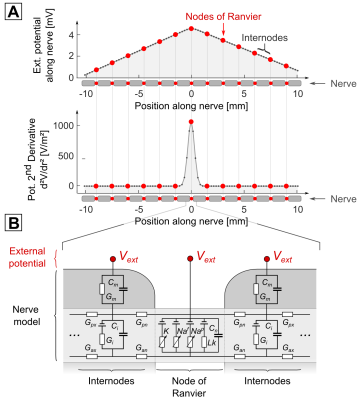 |
 Reduction of Peripheral Nerve Stimulation (PNS) using Pre-Excitation Targeting the Potassium System (PRE-TAPS) Reduction of Peripheral Nerve Stimulation (PNS) using Pre-Excitation Targeting the Potassium System (PRE-TAPS)
Mathias Davids, Bastien GuÚrin, Martin Schmelz, Lothar Schad, Lawrence Wald
PNS has become the main limitation of fast MRI using current gradient hardware. We recently presented a novel pipeline to simulate magnetically induced PNS thresholds in arbitrary coil geometries. Now, we use this framework and detailed modeling of ion dynamics and Action Potential (AP) generation to test a new strategy for PNS reduction. The method (which we call “PRE-TAPS”) pre-saturates the nerve membrane by playing gradient pulses prior to the main imaging gradient. Our model suggests that this simple pulse-sequence modification could effectively increase PNS thresholds by up to 30%.
|
16:27
 |
0293.
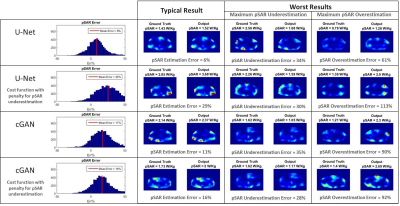 |
 On-line Subject-Specific Local SAR Assessment by Deep Learning On-line Subject-Specific Local SAR Assessment by Deep Learning
E.F. Meliado, A.J.E. Raaijmakers, M.H.F. Savenije, A. Sbrizzi, M. Maspero, P.R. Luijten, C.A.T. van den Berg
One of the most critical aspects that limits the application of ultra-high field MRI is the local Specific Absorption Rate (SAR) evaluation. The key aspect is that local SAR information could only be obtained by off-line simulation using generic body models, which hardly match with the patient's body and positioning. In this work we present a first deep learning approach for local SAR assessment. Results, show that the relation between local SAR on the one hand and MR Dixon images and B1-field maps on the other hand, can be accurately and instantaneously mapped by a Convolutional Neural Network (CNN).
|
16:39
|
0294.
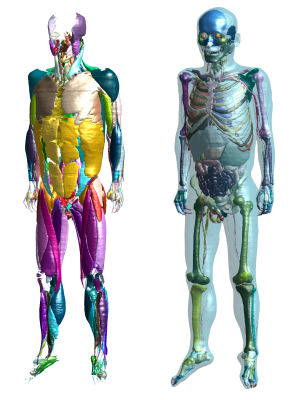 |
NEUROMAN: Reference Computational Human Phantoms for Evaluation of Safety Thresholds for Peripheral Nerve Stimulation
Video Permission Withheld
Bryn Lloyd, Antonino CassarÓ, Silvia Farcito, Esra Neufeld, Beom Sun Chung, Jin Seo Park, Min Suk Chung, Niels Kuster
The trend towards stronger magnetic fields and/or faster gradient switching in magnetic resonance imaging poses safety risks for patients, e.g., due to tissue heating and unwanted neurostimulation. The IEEE-ICES TC95 SC6 was formed to re-evaluate nerve excitation safety thresholds in response to temporal and spatial characteristics of electric fields induced by externally applied fields or implants. To this end, we are developing reference human anatomical models with unprecedented details in the peripheral nervous system, connectivity to organs and muscles, and functionalized with compartmental nerve models to investigate interactions with neuronal electrophysiology. We employ these phantoms to investigate current safety guidelines.
|
16:51
|
0295.
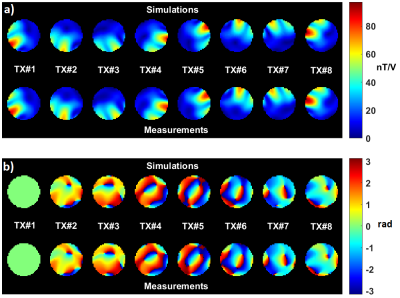 |
 Workflow proposal for defining SAR safety margins in parallel transmission Workflow proposal for defining SAR safety margins in parallel transmission
Nicolas Boulant, Vincent Gras, Alexis Amadon, Michel Luong, Guillaume Ferrand, Alexandre Vignaud
SAR calculations in parallel transmission (pTx) typically rely on electromagnetic simulations performed on generic models. Uncertainties however often exist due to tolerances in the lumped element values, cable losses, phase offsets and different coupling between transmit elements. Additional uncertainties in SAR evaluation include intersubject variability and exam supervision. In this work, we review a workflow that has been implemented in our laboratory with home-made and commercial pTx coils at 7T. Based on this strategy, nearly 100 healthy volunteers have been scanned with no reported incidents, while still allowing to exploit pTx to mitigate efficiently the RF inhomogeneity problem.
|
17:03
 |
0296.
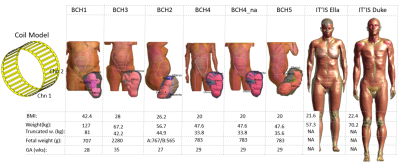 |
 SAR estimation error due to body model mismatch for fetal imaging at 3 Tesla SAR estimation error due to body model mismatch for fetal imaging at 3 Tesla
Filiz Yetisir, Esra Abaci Turk, Bastien Guerin, Borjan Gagoski, Natalie Copeland, P. Grant, Lawrence Wald, Elfar Adalsteinsson
RF safety concerns have been raised for both the mother and the fetus for 3 T fetal MRI. Parallel transmission can address these concerns by reducing the maternal and fetal SAR however it also relies on one or more body models to predict that individual’s local SAR. In this work, we assess the range of error incurred when various pregnant or non-pregnant models are used to predict SAR in pregnant patients. We model the degree of over or underestimation of SAR in 56 combinations of model/patient and find a maximum SAR under/over-estimation of 59%/142%.
|
17:15
|
0297.
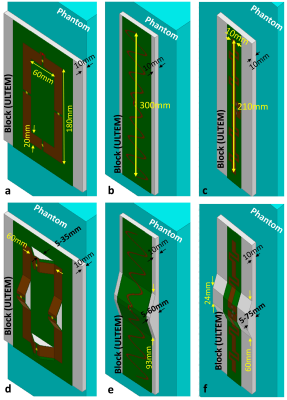 |
 Optimizing the Topography of Transmit Coils for SAR Management Optimizing the Topography of Transmit Coils for SAR Management
Alireza Sadeghi-Tarakameh, Angel Torrado-Carvajal, Cemre Ariyurek, Ergin Atalar, Gregor Adriany, Gregory J. Metzger, Russell L. Lagore, Lance DelaBarre, Andrea Grant, Pierre-Francois Van de Moortele, Kamil Ugurbil, Yigitcan Eryaman
Specific absorption rate (SAR) is a significant issue for ultra-high field (UHF, B0≥7T) imaging. In this study, we investigate a strategy based on optimizing the topography of transmit elements in 3D (i.e., adding bumps to a resonant planar structure) in order to reduce the local SAR while keeping B1+ efficiency constant inside a region of interest. For proof of concept, we modified three different resonant structures and compared their performance to previous designs with EM simulations. In addition, we built one of the proposed design and experimentally tested it using a whole-body 10.5T scanner.
|
17:27
|
0298.
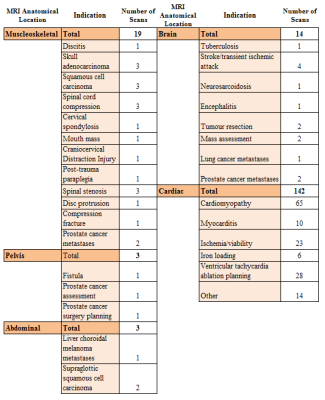 |
 Magnetic resonance imaging in patients with cardiac implanted electrical devices: single centre two year experience including thoracic imaging and non-MRI conditional devices. Magnetic resonance imaging in patients with cardiac implanted electrical devices: single centre two year experience including thoracic imaging and non-MRI conditional devices.
Joseph Martin, Anish Bhuva, Peter Kellman, Redha Boubertakh, Marc Miquel, Matthieu Ruthven, Adam Graham, Patricia Feuchter, Angela Hawkins, Richard Schilling, James Moon, Martin Lowe, Neha Sekhri, Charlotte Manisty
Over a million patients worldwide have cardiac implantable electronic devices (CIEDs), with a 50-75% lifetime MRI requirement. Although conventionally contraindicated, MRI-conditional CIEDs and evidence supporting safer scanning of non-MRI conditional CIEDs are changing practice. We report single center experience of CIED MRI scanning over 24 months. 179 MRI scans were acquired, 31% non-MRI conditional devices, 79% thoracic scans. Clinical impact was high (including cancer diagnosis and treatment planning, suspected cord compression and stroke). All patients were safely scanned with no clinically-significant events or device parameter changes resulting from MRI. These data support increased provision of MRI to CIED patients.
|
17:39
 |
0299.
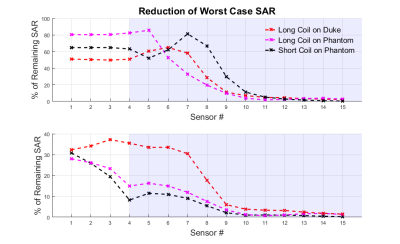 |
 Exploring the impact of nulling currents on a cardiac guidewire in reducing worst case SAR at 1.5T Exploring the impact of nulling currents on a cardiac guidewire in reducing worst case SAR at 1.5T
J. Nuno Teixeira, Felipe Godinez, Shaihan Malik, Jo Hajnal
MRI with non-MR compatible objects, namely wires, poses several challenges as risks of high Local SAR and reduced image quality due to B1 enhancement. In this work we looked at previously proved current nulling techniques and at their relationship with the reduction of worst case SAR scenarios. Results showed that current nulling leads to large reductions in worst case SAR, but that performance varies with coil design and sensor location. The analysis could be used to aid design of experimental setup for maximum safety.
|
17:51
|
0300.
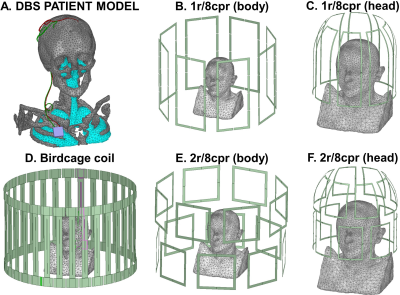 |
Reduction of the absorbed power around electrode tips in deep brain stimulation patients using pTx: Impact of number and arrangement of channels
Did Not Present
Bastien Guerin, Darin Dougherty, Lawrence Wald
We assess the potential of pTx for reduction of the absorbed power around electrode tips (APAET) in DBS patients using a realistic DBS patient model and electromagnetic field co-simulation. We simulate 5 coils, including a birdcage coil driven in quadrature and as a 2-channel pTx coil as well as four pTx coils with up to 16 channels arranged in up to two rows. We compare magnitude least square pulses with explicit constraints on the APAET and global SAR. We show that pTx, especially using head-only arrays, has the potential to alleviate the safety problem of DBS patients at 3 Tesla.
|
18:03
|
0301.
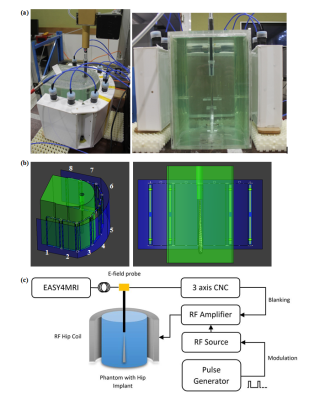 |
 Comparison between experimental and simulated electric fields near a hip implant in a parallel transmit hip coil Comparison between experimental and simulated electric fields near a hip implant in a parallel transmit hip coil
Aurelien Destruel, Miguel Fuentes, Ewald Weber, Kieran O'Brien, Markus Barth, Feng Liu, Stuart Crozier
The high conductivity of metal implants causes them to focus electric fields in tissue, which may increase the local temperature. In the case of parallel transmit (pTx) MRI, careful simulations of the patient and coil are required to predict heating, but validation of the simulations is challenging near metal implants. In this work, direct measurement of E-field near a hip prosthesis is performed inside a pTx hip coil, and results are compared with simulated data with and without considering decoupling. Neglecting decoupling leads to differences of up to 80% with measured data, showing the importance of realistic simulations.
|
|













